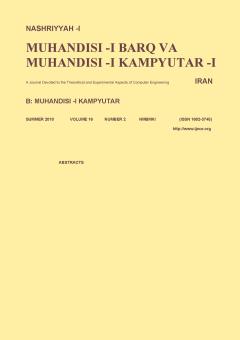کنترل توان و تخصیص زیرکانال در شبکه های دوسطحی ماکروسل و فمتوسل مبتنی بر OFDMA
الموضوعات :
1 - دانشگاه صنعتی امیرکبیر
2 - دانشگاه صنعتی امیرکبیر
الکلمات المفتاحية: شبکه های چندسطحیفمتوسلکنترل توان و تخصیص زیرکانالبهینه سازی محدبOFDMA,
ملخص المقالة :
شبکههای چندسطحی که شامل ماکروسل و فمتوسل هستند، منجر به افزایش ظرفیت شبکه و بهبود کیفیت سرویسهای ارائهشده به کاربران در شبکههای سلولار میشوند. تخصیص زیرکانال مشترک بین کاربران سطوح مختلف، باعث ایجاد تداخل بین سطحی بین کاربران میگردد که به دلیل اولویت بالاتر کاربران ماکروسل، حضور کاربران فمتوسل نباید مانع دستیابی این کاربران به حداقل کیفیت سرویس خود شوند. در این مقاله یک روش کنترل توان و تخصیص زیرکانال در حالت فروسو و در دو سطح ماکروسل و فمتوسل مبتنی بر OFDMA با هدف بیشینهکردن مجموع نرخ کاربران فمتوسلها، به نحوی که حداقل کیفیت سرویس برای همه کاربران ماکروسل و کاربران حساس به تأخیر فمتوسلها رعایت گردد ارائه میدهیم. در سطح ماکروسل دو مسئله متفاوت را به صورت جداگانه در نظر میگیریم. مسئله اول با هدف بیشینهنمودن مجموع آستانه تداخل بین سطحی قابل تحمل برای کاربران ماکروسل و مسئله دوم با هدف کمینهکردن مجموع توان ارسالی ماکروسل بیان میشود. مسئله در سطح فمتوسل، با هدف بیشینهنمودن مجموع نرخ داده کاربران فمتوسلها بیان میگردد. برای حل مسئله اول در سطح ماکروسل از الگوریتم مجارستانی که یک روش بهینه انتساب است استفاده مینماییم. همچنین برای حل مسئله دوم از یک روش مکاشفهای برای تخصیص زیرکانال و از روش دوگان لاگرانژ برای کنترل توان استفاده میگردد. برای حل مسئله در سطح فمتوسل نیز ابتدا با استفاده از یک روش مکاشفهای، تخصیص زیرکانال صورت میگیرد و سپس با استفاده از روش دوگان لاگرانژ که یکی از روشهای حل مسایل بهینهسازی محدب است، کنترل توان صورت میپذیرد. در انتها عملکرد این روش با تحلیل نتایج حاصل از شبیهسازی بررسی میگردد.
[1] R. Wang, H. Hu, and X. Yang, "Potentials and challenges of C-RAN supporting multi-RATs toward 5G mobile networks," IEEE Access vol. 2, pp. 1187-1195, 2014.
[2] A. Abdelnasser and E. Hossain, "Two-tier OFDMA cellular cloud-RAN: joint resource allocation and admission control," in Proc. IEEE Global Communications Conf., GLOBECOM’15, 7 pp., San Diego, CA, USA, 6-10 Dec. 2015.
[3] M. Adedoyin and O. Falowo, "Self-organizing radio resource management for next generation heterogeneous wireless networks," in Proc. IEEE Int. Conf. on Communications. ICC’16, 6 pp., Kuala Lumpur, Malaysia, 22-27 May 2016.
[4] A. Checko, et al., "Cloud RAN for mobile networks-a technology overview," IEEE Communications Surveys & Tutorials, vol. 17, no. 1, pp. 405-426, Firstquarter 2015.
[5] E. Dahlman, G. Mildh, S. Parkvall, J. Peisa, J. Sachs, and Y. Seln, "5G radio access," Ericsson Review, Jun. 2014.
[6] V. Chandrasekhar and J. G. Andrews, "Femtocell networks: a survey," IEEE Commun. Mag., vol. 46, no. 9, pp. 59-67, Sep. 2008.
[7] D. Fooladivanda and R. Catherine, "Joint resource allocation and user association for heterogeneous wireless cellular networks," IEEE Trans. on Wireless Communications, vol. 12, no. 1, pp. 248-257, Jan. 2013.
[8] M. Peng, Y. Li, J. Jiang, J. Li, and C. Wang, "Heterogeneous cloud radio access networks: a new perspective for enhancing spectral and energy efficiencies," IEEE Wireless Communications, vol. 21, no. 6, pp. 126-135, Dec. 2014.
[9] J. Kim and C. D. Ho, "A joint power and subchannel allocation scheme maximizing system capacity in indoor dense mobile communication systems," IEEE Trans. on Vehicular Technology, vol. 59, no. 9, pp. 4340-4353, Nov. 2010.
[10] V. N. Ha and B. L. Long, "Fair resource allocation for OFDMA femtocell networks with macrocell protection," IEEE Trans. on Vehicular Technology, vol. 63, no. 3, pp. 1388-1401, Mar. 2014.
[11] A. Abdelnasser, E. Hossain, and D. Kim, "Clustering and resource allocation for dense femtocells in a two-tier cellular OFDMA network," IEEE Trans. on Wireless Communications, vol. 13, no. 3, pp. 1628-1641, Mar. 2014.
[12] H. Zhang, C. Jiang, N. C. Beaulieu, X. Chu, X. Wen, and M. Tao, "Resource allocation in spectrum-sharing OFDMA femtocells with heterogeneous services," IEEE Trans. on Communications, vol. 62, no. 7, pp. 2366-2377, Jul. 2014.
[13] Y. Xu, Y. Hu, Q. Chen, R. Chai, and G. Li, "Distributed resource allocation for cognitive HetNets with cross-tier interference constraint," in Proc. IEEE Wireless Communications and Networking Conf., WCNC’17, 6 pp., San Francisco, CA, USA, 19-22 Mar. 2017.
[14] L. Giupponi and C. Ibars, "Distributed interference control in ofdmabased femtocells," in Proc. 21st Annual IEEE Int. Symp. on Personal, Indoor and Mobile Radio Communications PIMRC’10, pp. 1201-1206, Instanbul, Turkey, 26-30 Sept. 2010.
[15] N. Lu, Y. Jiang, F. Zheng, and X. You, "Energy efficient power control for the two-tier networks with small cells and massive MIMO," in Proc. Wireless Communications and Networking Conf. WCNC’16, pp. 127-132, Doha, Qatar, 3-6 Apr. 2016.
[16] D. T. Ngo, S. Khakurel, and T. Le-Ngoc, "Joint subchannel assignment and power allocation for OFDMA femtocell networks," IEEE Trans. on Wireless Communications, vol. 13, no. 1, pp. 342-355, Jan. 2014.
[17] A. Abdelnasser, E. Hossain, and D. Kim, "Tier-aware resource allocation in ofdma macrocell-small cell networks," IEEE Trans. on Communications, vol. 63, no. 3, pp. 695-710, Mar. 2015.
[18] W. L. Winston, Operations Research: Applications and Algorithms, Cengage Learning, 2003.
[19] A. Abdelnasser and E. Hossain, "Resource allocation for an OFDMA cloud-RAN of small cells overlaying a macrocell," IEEE Trans. on Mobile Computing, vol. 15, no. 11, pp. 2837-2850, Nov. 2016.
[20] R. Byers, "A bisection method for measuring the distance of a stable matrix to the unstable matrices," SIAM J. on Scientific and Statistical Computing, vol. 9, no. 5, pp. 875-881, 1988.
[21] K. Seong, M. Mohseni, and J. Cioffi, "Optimal resource allocation for OFDMA downlink systems," in Proc. IEEE Int. Symp. on Information Theory, pp. 1394-1398, Seattle, WA, USA, 9-14 Jul. 2006.
[22] S. Boyd and L. Vandenberghe, Convex Optimization, Cambridge, U. K.: Cambridge Univ. Press, 2004.
[23] D. W. K. Ng and R. Schober, "Resource allocation and scheduling in multi-cell ofdma systems with decode-and-forward relaying," IEEE Trans. Wireless Communications, vol. 10, no. 7, pp. 2246-2258, Jul. 2011.


